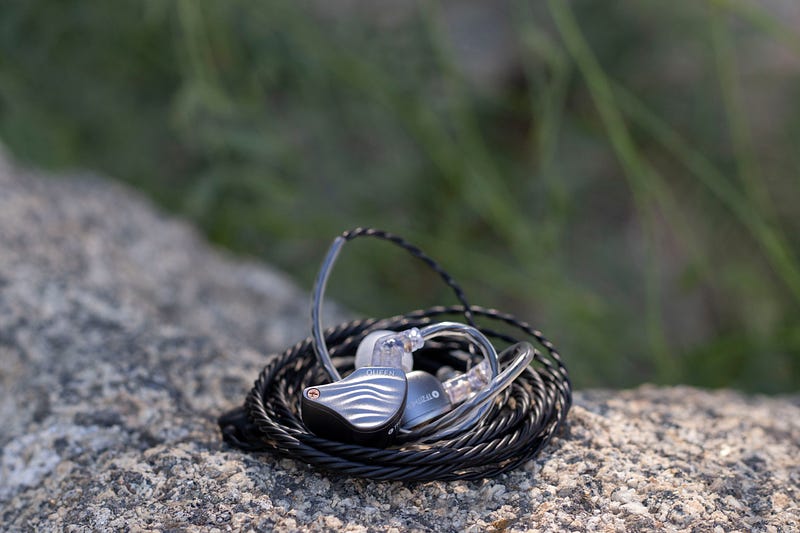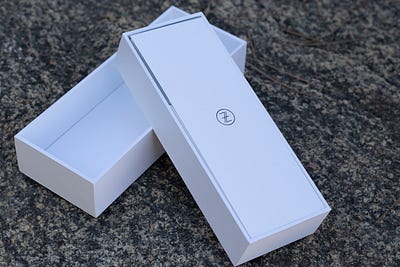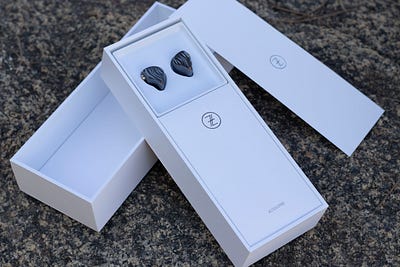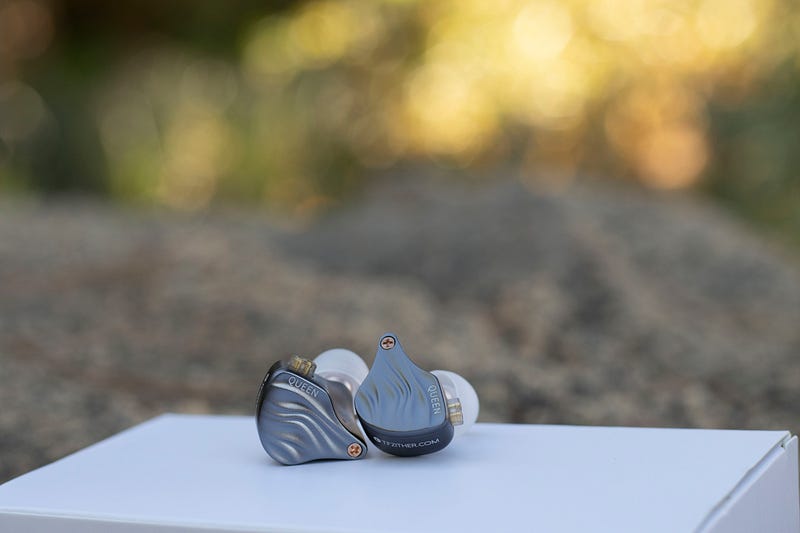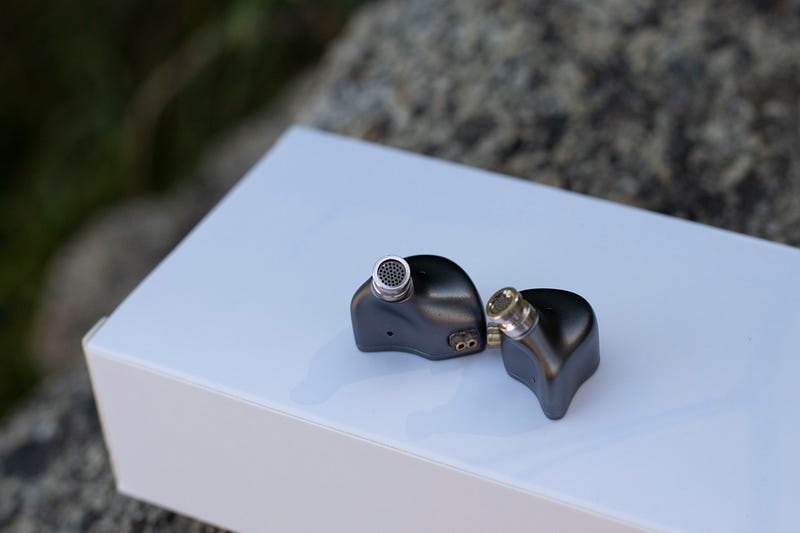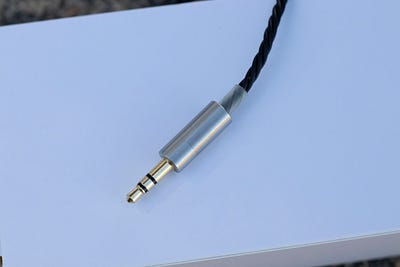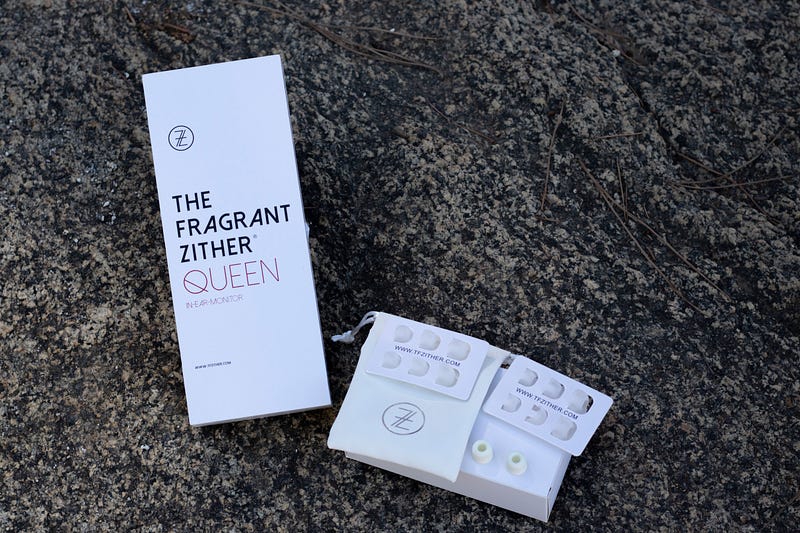Looks Noble as a Queen
About TFZ (The Fragrant Zither):
The company TFZ (The Fragrant Zither) is Chinese Company located in Shenzhen - China, which is specialized in the production of portable audio equipments like Earphones & In-Ear Monitors. The company is well known with some popular models like the TFZ Series, King, Exclusive and Tequila. The TFZ Queen, which I will review, is a new series with a pretty unique design language.
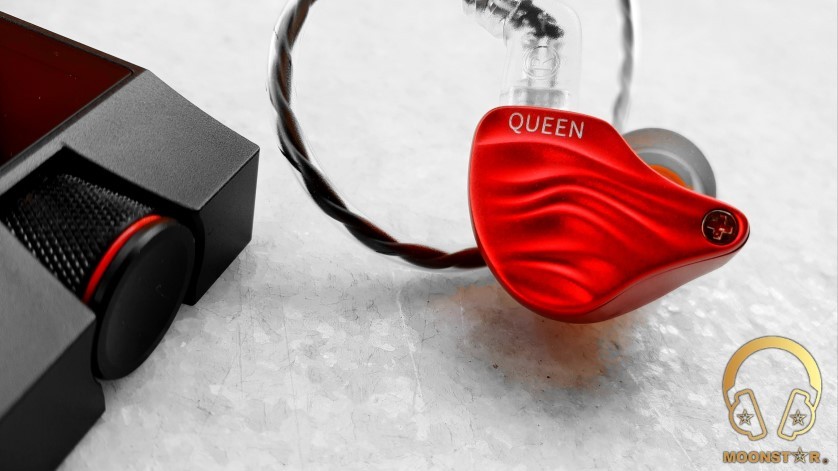
TFZ Official Website: http://www.tfzither.com/
About me: www.moonstarreviews.net
Disclaimer:
The TFZ Queen was provided to me by the company TFZ via Penon Audio for review purposes. I am not affiliated with TFZ or Penon Audio beyond this review and these words reflect my true and unaltered opinions about the product.
Price:
The MSRP price for the TFZ Queen is around 129,00 USD and can be purchased under the following link.
Purchase Link: https://penonaudio.com/tfz-queen.html
Package and Accessories:
The TFZ Queen comes in a rectangular white box, which is made of a pretty solid cardboard material that contains the following items;
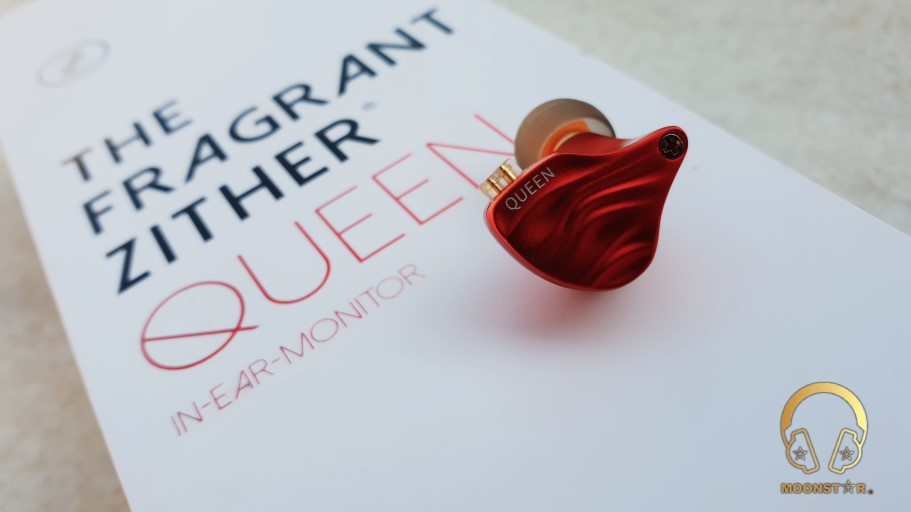

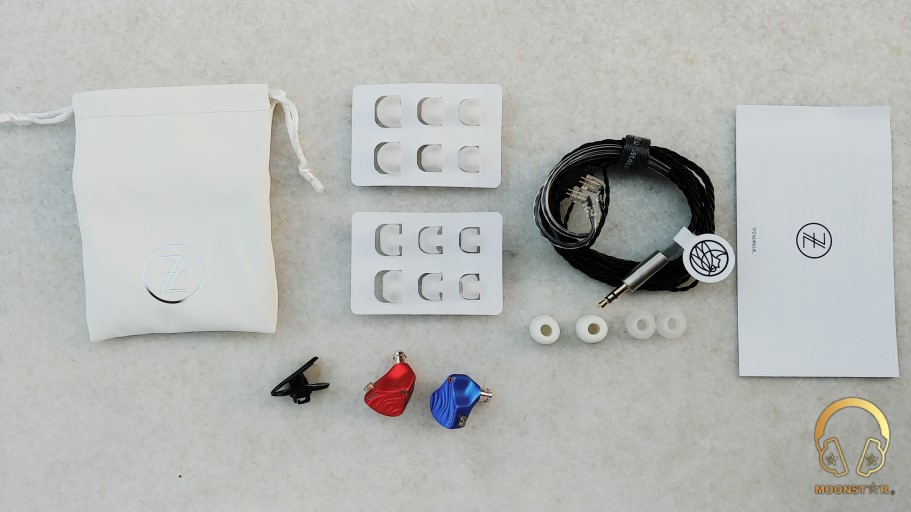
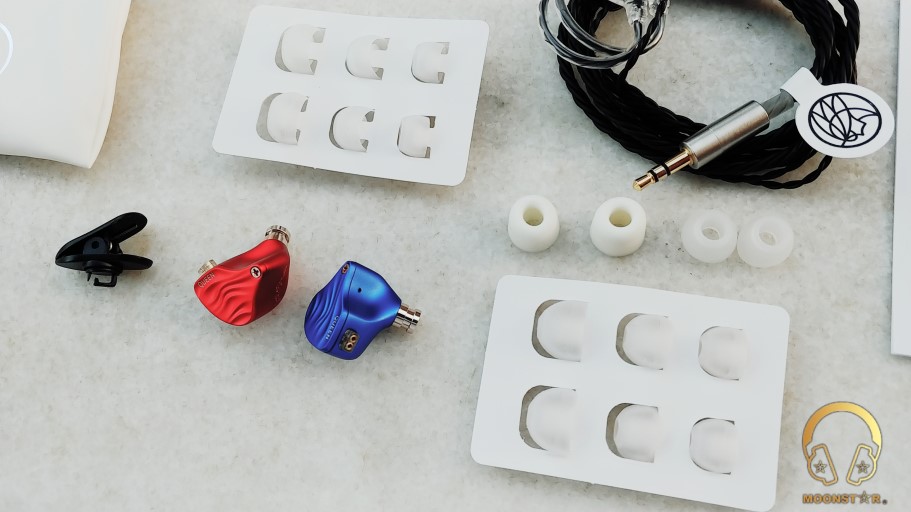

Design, Components and Build Quality:
The TFZ Queen is an In-Ear Monitor that has a pretty nice and unique design. The housing/ shell is made of two (2) CNC machined Aluminum Alloy parts that looks and feels solid in my hands.

The TFZ Queen IEM is available in four (4) different color options that are grey, red, blue and red&blue combinations like my review sample.
The Queen is an In-Ear Monitor that is producing the sound with a dynamic speaker. The speaker is made of Nano-graphene diaphragm and dual magnetic circuit with a N52 type high strength magnet.
On the front side that is named as the faceplate of the monitor is a small Queen logo and a little screw. This faceplate has a wave like pattern, which has a nice and unique appearance to my eyes.
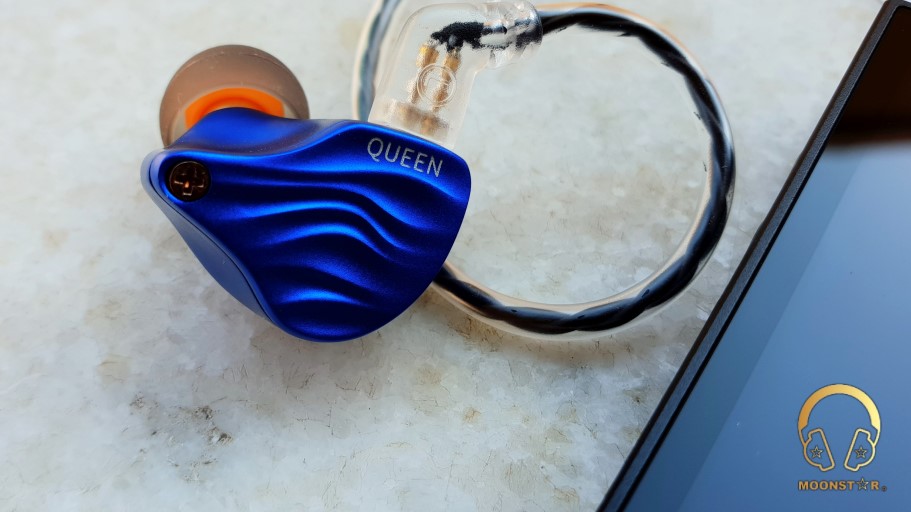
On the second part of the housing is a vent on the front size.
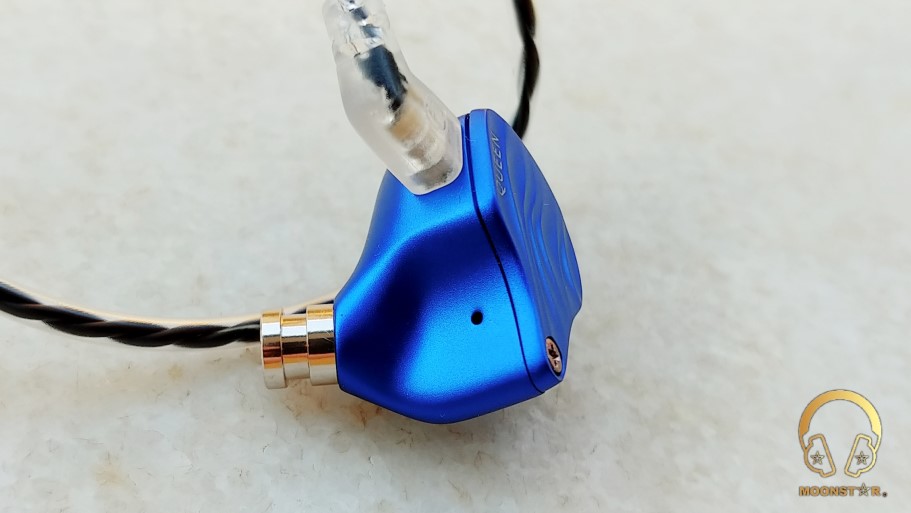
TFZ has printed their webpage www.tfzither.com in white color, on the back surface of the second part housing part.
On the inner side of this part that has contact to your outer ear is a second vent and the silver colored sound nozzle, which is mounted to this part.

On the Top of this monitor part is the type 0.78mm female 2pin connection.

The cable that comes with the TFZ Queen has a nice twisted profile and is made of an 4 core, 5N purity OFC (Oxygen Free Cooper) wire material, which has a soft rubber like black coating. This coating is very efficient to avoid any possible microphonic effect.
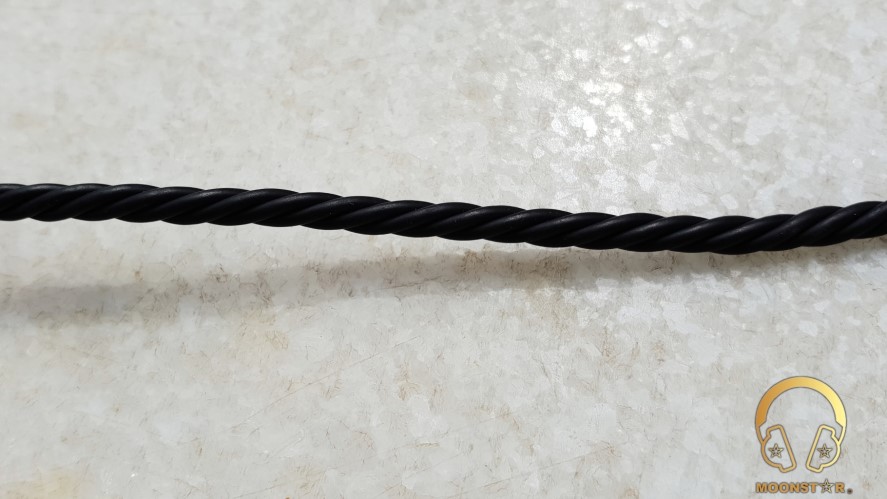
The 2pin male connectors have a transparent hard plastic housing, where you can find the left and right markings that are very hard to read and which is male only complain about this otherwise beautifully made cable.
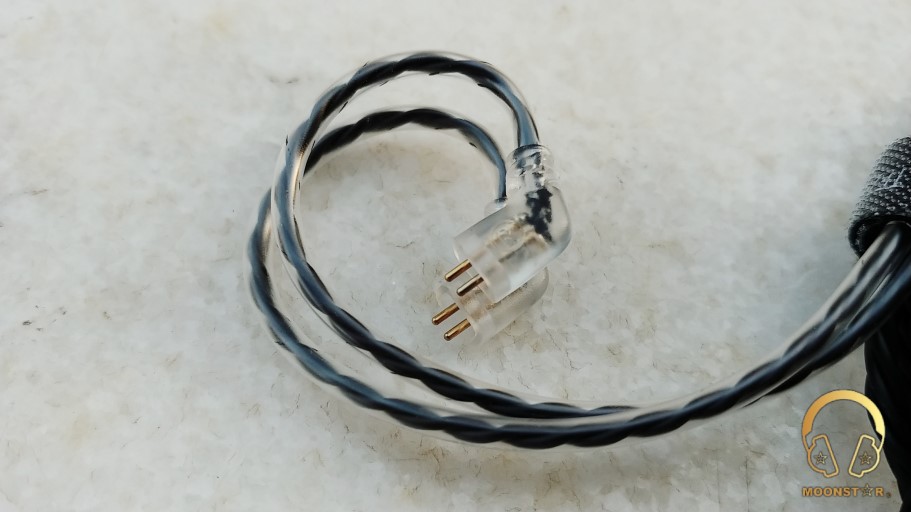
The cable has built-in ear guides near the connector for a better behind the ear comfort experience.
This cable has a Y splitter, which is made of a soft black colored plastic material that sports on both sides the new TFZ logos.

The 3.5mm unbalanced (3 pole) headphone jack has a straight profiled metal housing that sports also the TFZ logo.

Fit and Isolation:
The TFZ Queen has a nice and pretty comfortable shape, which makes long listening periods possible, without to hurt your ears. The isolation is average and is less successful than In-Ear Monitors with a Semi Custom like housing.
Technical Specs:
Drivability:
The TFZ Queen is a relative efficient In-Ear Monitor with an impedance of 30 Ohms, which makes it pretty suitable for the use with devices like phones, tablets, etc. that have less power than modern DAP’s or small portable amplifiers.
Albums & tracks used for this review:
Sources:
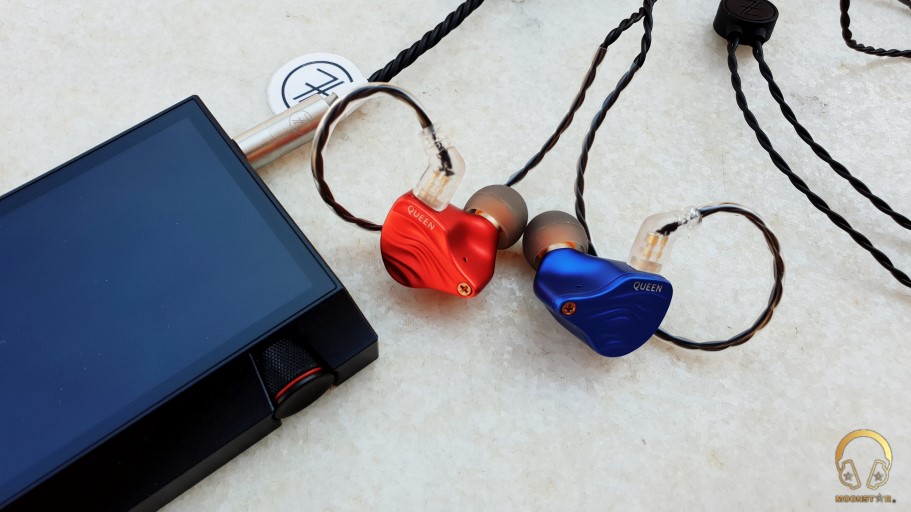
The Sound:
PS: The TFZ Queen review is written after a burn-in of around 80 hours. I have used the stock silicone ear tips with the wide sound bore and the stock cable that is included to the box.
The TFZ Queen has a petty warm tonality with noticeable emphasis in the lower frequency region; the result is a lush and full bodied overall presentation.
Bass:
The TFZ Queen sounds pretty rich in the lower frequency region and has a noticeable emphasis in both sub- and midbass areas.
The sub-bass rumble will satisfy many bass lovers with great rumble and full bodied presentation. The sub-bass is going pretty low and has an extension, which is on a moderate level, followed with average control and speed.
The mid-bass quantity and character give the sound a full-bodied and warm presentation, at the cost of the loss of clarity and definition. The overall bass detail is on a moderate level. The bass performance and character of the Queen is very suitable for those how are listening to genres like Trance, EDM and Pop music, where an extra boost in the lower frequency area is a welcome.
Instruments like guitars, drums or for example contrabass are sounding warmer and thicker than in natural.

Midrange:
The TFZ Queen has a smooth and relaxed midrange tuning with moderate transparency and pretty warm tonality. There are no negative situations like harshness or sibilance. Male vocals have a thick and deep presentation, while female vocals sounding lush, but lacking some transparency and sparkle. The midrange sounds pretty musical while it is missing a bit of clearness and airiness, which reminds me to the presentation of the Lear LUF Kaleido.
Some Instruments with ticker notes like drums or guitars sounding more realistic than those with thinner notes like pianos, flutes or violins. The overall detail level of instruments and vocals is on a moderate level and should be good enough with genres like Pop, EDM and Trance.
The upper midrange sounds very controlled and sibilance free and is ideal for those who are sensitive to upper midrange harshness. The upper midrange of the TFZ Queen is not very bright and upfront and is missing some crispiness and micro detail.
Treble:
The treble range of the TFZ Queen has moderate speed, sounds controlled and fatigue free, which makes it ideal for those who are sensitive to bright sources. The treble extension is on an average level with instruments like cymbals or violins, etc. The treble character is slightly thick due the warmth, which comes from the lower midrange are.
The upper treble range of the TFZ Queen is fairly controlled but is missing sparkle and clearness, which makes is less suitable with genres like metal music where you need additional vividness for instruments like cymbals, or with classical music where you can find flutes or violins. The overall detail level of the treble/upper treble range is average.
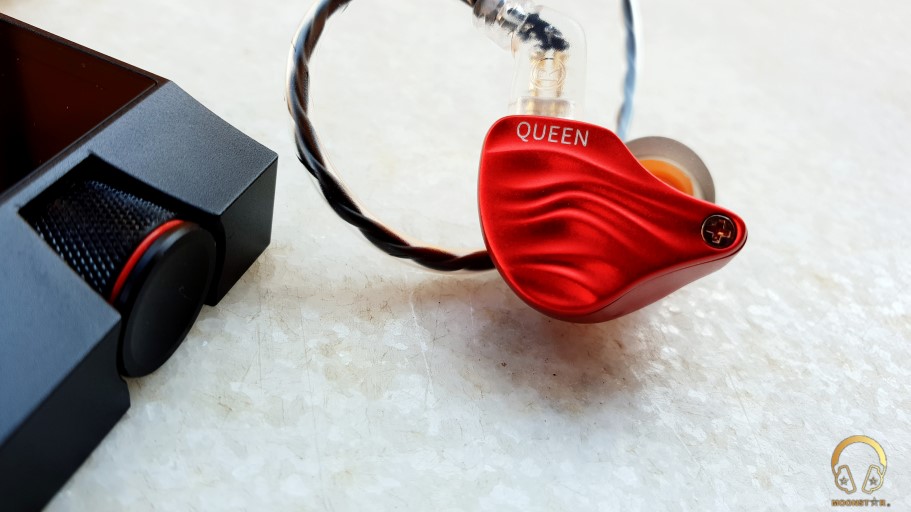
Soundstage:
The soundstage performance of the TFZ Queen is average, with slightly less depth than wideness, which should be pretty ok for genres like pop, rock or electronic music, but sound a bit too closed in with genres like classical, jazz or acoustic music. The amount of rendered air between instruments is pretty good, but the separation of instruments is at an average level.
Comparisons:
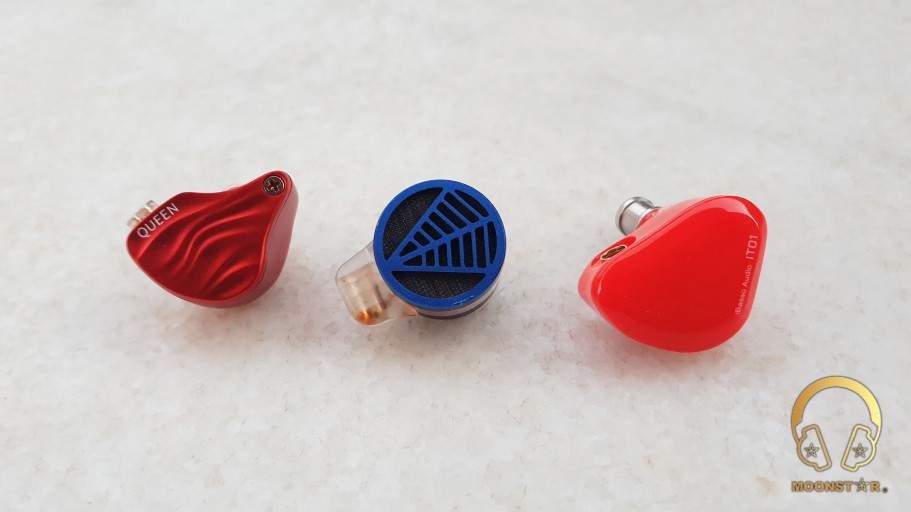
TFZ Queen versus TFZ Tequila1:
The TFZ Queen and TFZ Tequila have some similarities, but also many differences in their presentation.
The bass sub-bass area of the Queen and Tequila1 sounds pretty similar with nice rumble and good depth for this price range. The sub-bass of the Queen have lightly better extension than those of the Tequila1 while the overall quantity is nearly the same.
The Queen has more mid-bass quantity and fullness, but sounds not as fast and controlled like the Tequila1, which performs better in this area. Faster bass response means also better detail rendering, where the Tequila1 is slightly better.
The midrange of the TFZ Tequila1 sounds brighter and more transparent than those of the TFZ Queen, which has a thicker and warmer tonality in this region. Male vocals sounding in general more lush with Queen because of the thicker and deeper presentation, while female vocals are more successful with the Tequila1 due to the additional sparkle and transparency that comes from the upper midrange area.
When it comes to the instrument presentation, I would prefer the Queen with synthetic instruments or guitars and drums, while the Tequila1 is suitable with instruments that need additional brightness and upper midrange presence like piano, flutes or violins.
The treble range of the Tequila1 has more presence, sounds also more spacious and airy compared to the Queen, which has a smoother and softer presentation. The Tequila1 has slightly better treble extension and sound also more lifelike but with a little bit of harshness, especially with bad recorded tracks.
The soundstage performance of the Queen and the Tequila1 is pretty close. The Tequila1 has a slightly wider soundstage, while the difference for the depth is less noticeable, maybe a hint better with the Tequila1.
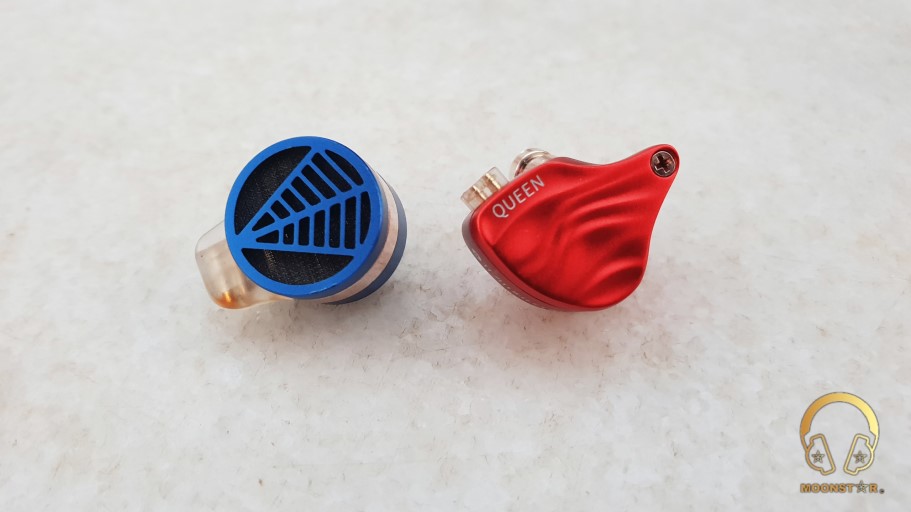
TFZ Queen versus iBasso IT01:
The TFZ Queen sounds slightly fuller and has also some additional bass emphasis compared to the iBasso IT01. The sub-bass of the Queen have more quantity, sense of rumble and depth, while the IT01 has slightly better control over this frequency region.
The mid-bass of the TFZ Queen is sounding fuller, thicker and has a lush character, while the mid-bass presentation of the iBasso IT01 is tighter and faster, than those of the Queen.
The Midrange of the Queen sounds thicker, warmer and more gentle than those of the IT01, which has a slightly more energetic and brighter presentation that shows also additional cleaners.
The mid-bass boost of the Queen makes male vocals fuller and is adding additional depth, while the more prominent upper midrange of the IT01 is adding female vocals a touch more sparkle and cleaners. The same situation continues for instruments, where the Queen is more suitable with instruments with thicker and the IT01 the better choice for instruments that need more brightness and saturation.
The treble range of the iBasso IT01 is brighter, sharper and slightly more detailed than those of the TFZ Queen. The Queen sounds slightly more controlled and is also smoother in its presentation, which makes it to the better choice for those who are treble sensitive. The treble extension of the iBasso IT01 is also better than those of the TFZ Queen.
When it comes to the soundstage performance, the iBasso IT01 has slightly more depth and a wider soundstage. The IT01 has also a little bit better instrument separation and is more precise regarding to the placement.
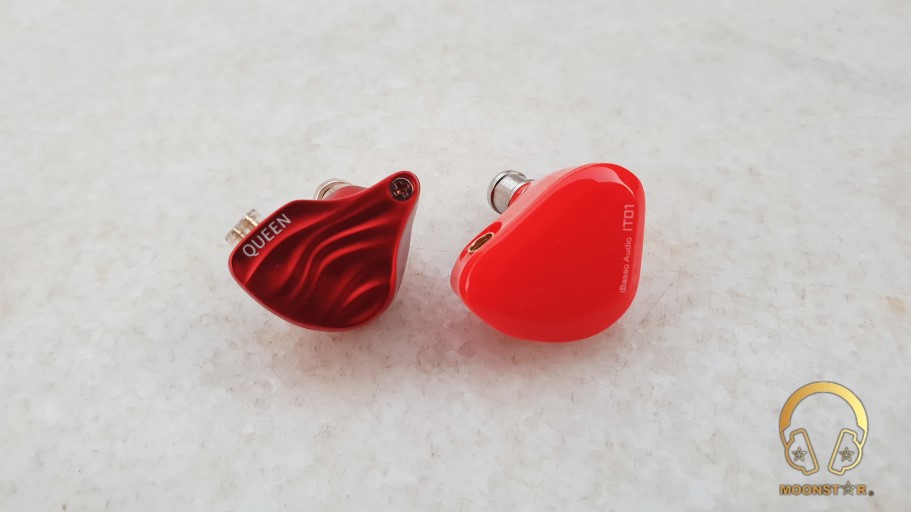
Conclusion:
The TFZ Queen is one of my favorite IEM’s when it comes to design, comfort and build quality. The sound has also a nicely done romantic tuning with its warm, thick and smooth presentation, which makes it to a good option for those, who don’t listen very complex genres like classical, progressive metal music and also don’t like oversaturated brightness.
Pros and Cons:
About TFZ (The Fragrant Zither):
The company TFZ (The Fragrant Zither) is Chinese Company located in Shenzhen - China, which is specialized in the production of portable audio equipments like Earphones & In-Ear Monitors. The company is well known with some popular models like the TFZ Series, King, Exclusive and Tequila. The TFZ Queen, which I will review, is a new series with a pretty unique design language.

TFZ Official Website: http://www.tfzither.com/
About me: www.moonstarreviews.net
Disclaimer:
The TFZ Queen was provided to me by the company TFZ via Penon Audio for review purposes. I am not affiliated with TFZ or Penon Audio beyond this review and these words reflect my true and unaltered opinions about the product.
Price:
The MSRP price for the TFZ Queen is around 129,00 USD and can be purchased under the following link.
Purchase Link: https://penonaudio.com/tfz-queen.html
Package and Accessories:
The TFZ Queen comes in a rectangular white box, which is made of a pretty solid cardboard material that contains the following items;
- 1 pair x TFZ Queen In-Ear Monitor
- 1 pcs x Detachable cable with 0,78mm 2 pin connection
- 1 pair x Foam ear tips
- 3 pair x Silicone ear tips with wide-bore
- 4 pair x Silicone ear tips with small-bore (1 pair came preinstalled)
- 1 pcs x White Carry Pouch
- 1 pcs x Shirt Clip





Design, Components and Build Quality:
The TFZ Queen is an In-Ear Monitor that has a pretty nice and unique design. The housing/ shell is made of two (2) CNC machined Aluminum Alloy parts that looks and feels solid in my hands.

The TFZ Queen IEM is available in four (4) different color options that are grey, red, blue and red&blue combinations like my review sample.
The Queen is an In-Ear Monitor that is producing the sound with a dynamic speaker. The speaker is made of Nano-graphene diaphragm and dual magnetic circuit with a N52 type high strength magnet.
On the front side that is named as the faceplate of the monitor is a small Queen logo and a little screw. This faceplate has a wave like pattern, which has a nice and unique appearance to my eyes.

On the second part of the housing is a vent on the front size.

TFZ has printed their webpage www.tfzither.com in white color, on the back surface of the second part housing part.
On the inner side of this part that has contact to your outer ear is a second vent and the silver colored sound nozzle, which is mounted to this part.

On the Top of this monitor part is the type 0.78mm female 2pin connection.

The cable that comes with the TFZ Queen has a nice twisted profile and is made of an 4 core, 5N purity OFC (Oxygen Free Cooper) wire material, which has a soft rubber like black coating. This coating is very efficient to avoid any possible microphonic effect.

The 2pin male connectors have a transparent hard plastic housing, where you can find the left and right markings that are very hard to read and which is male only complain about this otherwise beautifully made cable.

The cable has built-in ear guides near the connector for a better behind the ear comfort experience.
This cable has a Y splitter, which is made of a soft black colored plastic material that sports on both sides the new TFZ logos.

The 3.5mm unbalanced (3 pole) headphone jack has a straight profiled metal housing that sports also the TFZ logo.

Fit and Isolation:
The TFZ Queen has a nice and pretty comfortable shape, which makes long listening periods possible, without to hurt your ears. The isolation is average and is less successful than In-Ear Monitors with a Semi Custom like housing.
Technical Specs:
- Driver : Dual magnetic circuit driver with graphite diaphragm & high strength magnet
- Freq. Range : 5HZ ~ 40000HZ
- Impedance : 30Ω
- Sensitivity : 110dB±3dB
- Connectors : 2-pin 0.78mm
- Plug : 3.5mm gold-plated
- Wire Material : PVC+5N oxygen-free copper
- Cable length : 1.2M
Drivability:
The TFZ Queen is a relative efficient In-Ear Monitor with an impedance of 30 Ohms, which makes it pretty suitable for the use with devices like phones, tablets, etc. that have less power than modern DAP’s or small portable amplifiers.
Albums & tracks used for this review:
- Morbid Angel – Drum Check (Spotify)
- Liquid Tension Experiment 2 – Acid Rain (Spotify)
- Metallica – Sad But True (Flac 24bit/96kHz)
- Opeth – Damnation (Tidal Hi-Fi)
- Megadeth – Sweating Bullets (Flac 16bit/44kHz)
- Sertab Erener – Aşk (Spotify)
- Minor Empire – Bulbulum Altin Kafeste (Spotify)
- London Grammar – Interlud (Live) (Flac 24bit/44kHz)
- The Glitch Mob – Mind of A Beast (Flac 24bit/96kHz)
- Lorde – Team (Flac 24bit/48kHz)
- Tom Player – Resonace Theory “Album” (Tidal Hi-Fi)
- Deeperise feat. Jabbar – Move On (Spotify)
- Dire Straits – Money for Nothing (DSD 64)
- Steve Srauss – Mr. Bones (Flac 16bit/44kHz)
- Charly Antolini’s – Duwadjuwandadu (Tidal Hi-Fi)
- Casey Abrams – Robot Lover (Tidal Hi-Fi)
- GoGo Penguin – Fanfares (Tidal Hi-Fi)
Sources:
- IEM’s : TFZ Queen, TFZ Tequila1, iBasso IT01
- DAP/DAC/AMP’s : Cayin N5II, Fiio M7, Astell&Kern AK70, Chord Mojo, xDuoo XD10 Poke,

The Sound:
PS: The TFZ Queen review is written after a burn-in of around 80 hours. I have used the stock silicone ear tips with the wide sound bore and the stock cable that is included to the box.
The TFZ Queen has a petty warm tonality with noticeable emphasis in the lower frequency region; the result is a lush and full bodied overall presentation.
Bass:
The TFZ Queen sounds pretty rich in the lower frequency region and has a noticeable emphasis in both sub- and midbass areas.
The sub-bass rumble will satisfy many bass lovers with great rumble and full bodied presentation. The sub-bass is going pretty low and has an extension, which is on a moderate level, followed with average control and speed.
The mid-bass quantity and character give the sound a full-bodied and warm presentation, at the cost of the loss of clarity and definition. The overall bass detail is on a moderate level. The bass performance and character of the Queen is very suitable for those how are listening to genres like Trance, EDM and Pop music, where an extra boost in the lower frequency area is a welcome.
Instruments like guitars, drums or for example contrabass are sounding warmer and thicker than in natural.

Midrange:
The TFZ Queen has a smooth and relaxed midrange tuning with moderate transparency and pretty warm tonality. There are no negative situations like harshness or sibilance. Male vocals have a thick and deep presentation, while female vocals sounding lush, but lacking some transparency and sparkle. The midrange sounds pretty musical while it is missing a bit of clearness and airiness, which reminds me to the presentation of the Lear LUF Kaleido.
Some Instruments with ticker notes like drums or guitars sounding more realistic than those with thinner notes like pianos, flutes or violins. The overall detail level of instruments and vocals is on a moderate level and should be good enough with genres like Pop, EDM and Trance.
The upper midrange sounds very controlled and sibilance free and is ideal for those who are sensitive to upper midrange harshness. The upper midrange of the TFZ Queen is not very bright and upfront and is missing some crispiness and micro detail.
Treble:
The treble range of the TFZ Queen has moderate speed, sounds controlled and fatigue free, which makes it ideal for those who are sensitive to bright sources. The treble extension is on an average level with instruments like cymbals or violins, etc. The treble character is slightly thick due the warmth, which comes from the lower midrange are.
The upper treble range of the TFZ Queen is fairly controlled but is missing sparkle and clearness, which makes is less suitable with genres like metal music where you need additional vividness for instruments like cymbals, or with classical music where you can find flutes or violins. The overall detail level of the treble/upper treble range is average.

Soundstage:
The soundstage performance of the TFZ Queen is average, with slightly less depth than wideness, which should be pretty ok for genres like pop, rock or electronic music, but sound a bit too closed in with genres like classical, jazz or acoustic music. The amount of rendered air between instruments is pretty good, but the separation of instruments is at an average level.
Comparisons:

TFZ Queen versus TFZ Tequila1:
The TFZ Queen and TFZ Tequila have some similarities, but also many differences in their presentation.
The bass sub-bass area of the Queen and Tequila1 sounds pretty similar with nice rumble and good depth for this price range. The sub-bass of the Queen have lightly better extension than those of the Tequila1 while the overall quantity is nearly the same.
The Queen has more mid-bass quantity and fullness, but sounds not as fast and controlled like the Tequila1, which performs better in this area. Faster bass response means also better detail rendering, where the Tequila1 is slightly better.
The midrange of the TFZ Tequila1 sounds brighter and more transparent than those of the TFZ Queen, which has a thicker and warmer tonality in this region. Male vocals sounding in general more lush with Queen because of the thicker and deeper presentation, while female vocals are more successful with the Tequila1 due to the additional sparkle and transparency that comes from the upper midrange area.
When it comes to the instrument presentation, I would prefer the Queen with synthetic instruments or guitars and drums, while the Tequila1 is suitable with instruments that need additional brightness and upper midrange presence like piano, flutes or violins.
The treble range of the Tequila1 has more presence, sounds also more spacious and airy compared to the Queen, which has a smoother and softer presentation. The Tequila1 has slightly better treble extension and sound also more lifelike but with a little bit of harshness, especially with bad recorded tracks.
The soundstage performance of the Queen and the Tequila1 is pretty close. The Tequila1 has a slightly wider soundstage, while the difference for the depth is less noticeable, maybe a hint better with the Tequila1.

TFZ Queen versus iBasso IT01:
The TFZ Queen sounds slightly fuller and has also some additional bass emphasis compared to the iBasso IT01. The sub-bass of the Queen have more quantity, sense of rumble and depth, while the IT01 has slightly better control over this frequency region.
The mid-bass of the TFZ Queen is sounding fuller, thicker and has a lush character, while the mid-bass presentation of the iBasso IT01 is tighter and faster, than those of the Queen.
The Midrange of the Queen sounds thicker, warmer and more gentle than those of the IT01, which has a slightly more energetic and brighter presentation that shows also additional cleaners.
The mid-bass boost of the Queen makes male vocals fuller and is adding additional depth, while the more prominent upper midrange of the IT01 is adding female vocals a touch more sparkle and cleaners. The same situation continues for instruments, where the Queen is more suitable with instruments with thicker and the IT01 the better choice for instruments that need more brightness and saturation.
The treble range of the iBasso IT01 is brighter, sharper and slightly more detailed than those of the TFZ Queen. The Queen sounds slightly more controlled and is also smoother in its presentation, which makes it to the better choice for those who are treble sensitive. The treble extension of the iBasso IT01 is also better than those of the TFZ Queen.
When it comes to the soundstage performance, the iBasso IT01 has slightly more depth and a wider soundstage. The IT01 has also a little bit better instrument separation and is more precise regarding to the placement.

Conclusion:
The TFZ Queen is one of my favorite IEM’s when it comes to design, comfort and build quality. The sound has also a nicely done romantic tuning with its warm, thick and smooth presentation, which makes it to a good option for those, who don’t listen very complex genres like classical, progressive metal music and also don’t like oversaturated brightness.
Pros and Cons:
- + Beautiful design
- + Great build quality, solid metal housing
- + Detachable cable and rich accessories package
- + Great bass and full bodied sound
- + Warm, smooth and relaxing sound presentation
- - Missing some presence in the treble and upper midrange region
- - Slightly warm for my preference
- - Average separation

